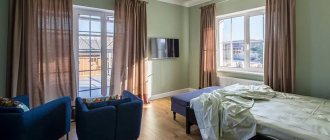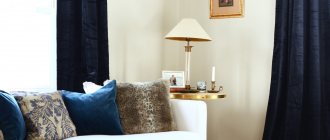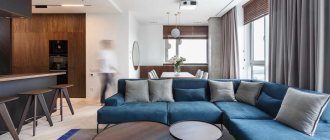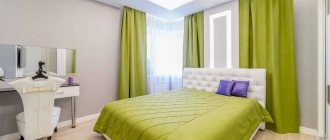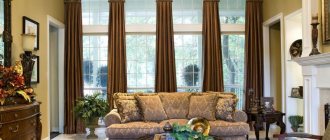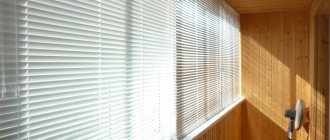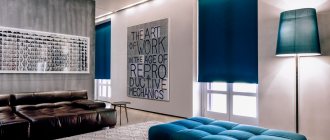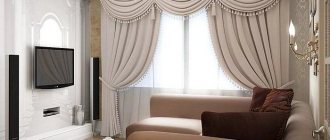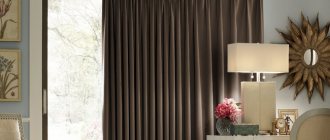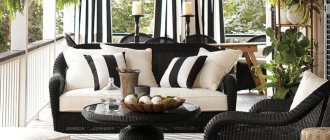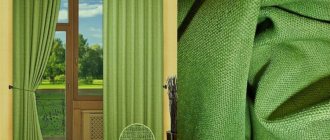The environmental friendliness and external beauty of a material such as linen captivates many in interior design. A room with linen textiles is always cozy, comfortable and warm. Today we’ll talk about curtains: their varieties, color combinations, advantages and disadvantages.
Types of linen fabrics
Initially, many people associate linen with a rather rough and inelastic fabric. But this is absolutely not true. Once upon a time in Ancient Egypt, up to 250 m of the finest linen threads were obtained from just 1 kg of raw materials, and the linen itself was incredibly delicate, flexible and light. Its price was not cheap, so only rich people bought clothes made from such fabric, while ordinary people were really content with hard and rough fabric. Today, the textile industry produces a variety of types of linen, from which you can choose curtains (or fabrics) for any interior.
Unbleached linen looks like homespun fabric with dark gray-brown tones, on the surface of which the weaving of threads is clearly visible. Designers prefer to use this type of linen fabric in safari, rustic, Scandinavian, eco and other design directions that are as close to simplicity and naturalness as possible.
Lightened canvases in gray-white, cream, milky shades look fresh and airy. Such curtains create a special light and cozy atmosphere in the design of Provence, grunge, country and will be an excellent choice in the interior of the kitchen.
Active designers use dense fabric with a pronounced relief texture to decorate bedrooms and living rooms. Such linen textiles look expensive and luxurious, while preserving the natural beauty of the material. In modern, gothic, and African styles, linen will be incredibly organically combined with decorative elements.
Linen with silk, as well as with lavsan, with a pleasant matte sheen, further ennobles the interior in a classic, antique, art deco style. Such bedspreads and curtains give the room sophistication, sophistication, aristocratic luxury, and emphasize the richness of the interior.
Note: when choosing linen textiles for curtains, pay attention to the pattern. Greek print looks harmonious in antique design, and floral pattern is best used for oriental, colonial or Slavic style.
Curtain sizes
There are no specific standards when choosing the length, so only the functional features of the window are taken into account here.
Short
Linen curtains, shortened to the window sill, of a simple cut, will look especially appropriate on a window near which a sofa, table or other interior items are located. They allow you to save space.
The photo shows the kitchen interior and short linen curtains on the windows.
Long
Particularly suitable for decorating living rooms, bedrooms or children's rooms. Such canvases look elegant and give the window opening a complete look. However, too long curtains lying on the floor get dirty very quickly.
Advantages and disadvantages of flax
When choosing any fabric, we first of all pay attention to its quality and properties. Even an amateur understands that wool cannot withstand high temperatures, and cotton wrinkles badly. Let's see what the pros and cons of flax are.
Linen perfectly allows heat and air to pass through, which is good for health. The material has high environmental qualities and does not cause any allergic reactions.
Flax fiber itself is very durable, which determines its long service life. Suffice it to recall how linen products, having experienced numerous washes, were passed on by inheritance, but at the same time retaining their presentable appearance. However, keep in mind that after washing, linen fabric shrinks by 7%. Therefore, when calculating the footage of curtains, buy textiles with a margin.
Pure linen fabric, without additives, wrinkles quite a lot. Perhaps this is the main disadvantage of natural flax. Each wash is not complete without long and thorough ironing of linen curtains to give them a flawless, smooth look.
Tip: it is better not to use aggressive detergents when washing linen curtains. Otherwise, the fabric may quickly become thin and lose its original attractiveness. To avoid stains, buy powders that do not contain chlorine.
Flax is not terrible if it is properly cared for!
Linen curtains need regular ventilation. Twice a year they need to be vacuumed with a soft brush.
- It is recommended to wash colored items in warm water (up to 40°C) with neutral detergents. Bleaching with chlorine-containing substances is unacceptable.
- Lightened linen can be machine washed at temperatures up to 90°C.
- Linen cannot be dried in automatic drums.
- After washing, the curtains are shaken, straightened and hung to dry.
- Curtains are ironed while wet with the hottest iron.
- Before storage, linen curtains are washed and ironed.
- Store curtains wrapped in wrapping paper.
Linen curtains are always a delicate work of the designer using luxurious natural material. This is a sensitive appeal to nature itself and a respectful emphasis on its perfection.
Universal, like everything harmonious, and practical, like everything universal, linen curtains will for a long time become the best and useful decoration for the interior of any living room.
© 2022 textiletrend.ru
Color combination and decoration
When decorating the interior, remember that linen does not have rich, bright or snow-white colors. The whole highlight of this textile is in its pastel, delicate and soft tones of the creamy beige spectrum. Therefore, linen fabric in the interior is universal in terms of combining shades. There are almost no prohibitions for her.
Linen textiles will add sophistication and originality to the kitchen and living room in purple, blue or peach colors. In a brown, green, white interior, linen curtains will be as harmonious as possible. And the snow-white background of the walls will not overshadow the natural fabric at all, and all thanks to its texture!
The decorative component of linen curtains is most often lace or embroidery. Lace braid or hemstitch visually lightens the fabric and creates a feeling of some airiness. Curtains with similar decor look charming both in the bedroom and in the kitchen.
A magnificent effect is produced by combining linen curtains with tulle or a snow-white veil.
In drapery, this material is quite complex. Natural beauty is created by vertical folds, but Austrian curtains, cascades or lambrequins turn into a pile of fabrics, devoid of any aesthetics and smoothness of waves. The laconic simplicity in the design of such curtains looks much more interesting and comfortable.
Linen fabric with embroidery is aerobatics. Both cross stitch and satin stitch fit flawlessly on linen. The fabric plays in a completely new way, and a special atmosphere, style and color appear in the interior.
Features of window decoration with tulle and embroidery + photo
Embroidery decorates any item, be it a wardrobe item, a decorative pillow or a curtain. On curtains this decor looks especially elegant and stylish. The main thing is to find a harmonious combination of curtains and tulle.
For a modern interior, it is better to use embroidery with lines and simple geometry.
Typically, designers are guided by the following rule: if the tulle is embroidered, then the curtain is plain; if the curtain is decorated with ornaments, then the light fabric should be as laconic as possible. But modern fashion trends allow some deviation from this rule. It is important that everything is in moderation.
The choice of pattern on the curtains depends on personal preferences and the kind of atmosphere you want to create.
In this case, both the light fabric and the curtain have a pattern, however, with the laconic design of the walls it does not look provocative.
An unusual solution: embroidered tulle is placed on top of plain tulle. The non-standard design gives the interior a special chic.
The combination of light curtains with a tulle curtain is suitable for a room with north-facing windows, and even for south-facing windows if you add blinds or a Roman shade
Thanks to the voluminous and bright embroidery, the fabric can be used as an independent element of the interior, without curtains or blinds.
French curtains made of translucent white fabric look elegant
The fact remains that, despite the long history of its existence, tulle has not lost its relevance and is still in demand. And thanks to new technologies, it has become a more interesting and functional element of window space design.
Linen in interior design
As mentioned earlier, linen is quite common in interiors. This material is especially loved by designers when decorating rooms with natural fabrics. The popular soft beige tone of the canvas is a universal material for curtains in almost any interior. Pastel Provence or presentable classics, national original flavor or rustic minimalism - in each of these styles linen looks very organic.
This practical material is especially in demand when decorating windows in the kitchen. In the living room, linen textiles give a fascinating play of light, thanks to the folds of the fabric, randomly transmitting the bright rays of the sun. If you want to emphasize the expensive minimalism of linen curtains, combine them with light cambric or mesh tulle. You can add a touch of luxury to the interior of the front room using linen with sewn satin inserts or metallic thread.
Nowadays, people sometimes lack unity with nature. And natural materials in the home interior are a real salvation. Linen is perfect in this regard; it fills our everyday life with comfort, warmth and harmony.
Options for attaching to the cornice
There are several types of fastening:
- Eyelets. Such additional elements give the curtains style and chic.
- Loops. Using loops you can create an unusual curtain design.
- Rings. They are distinguished by great variety and are often used to decorate curtains. They give the curtains a finished and sophisticated look.
- Ties. Decorative bows and knots are a fairly common fastening option for light linen fabrics.
